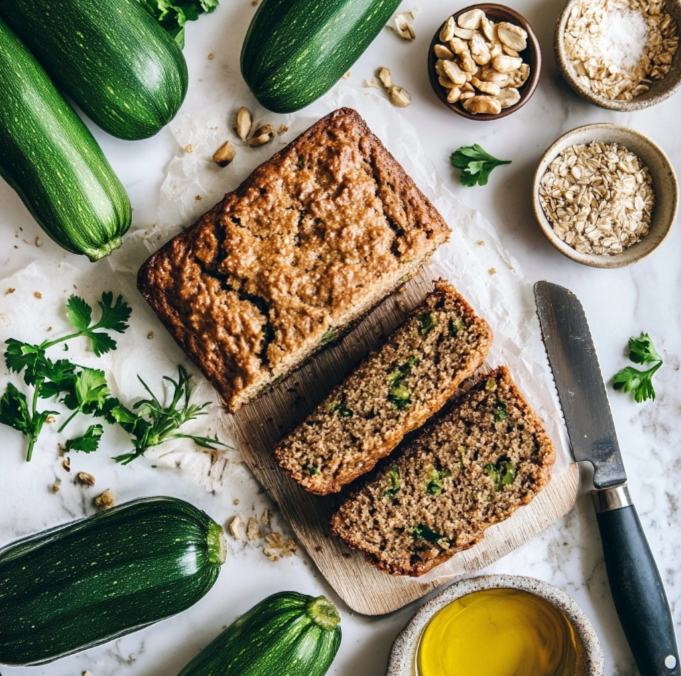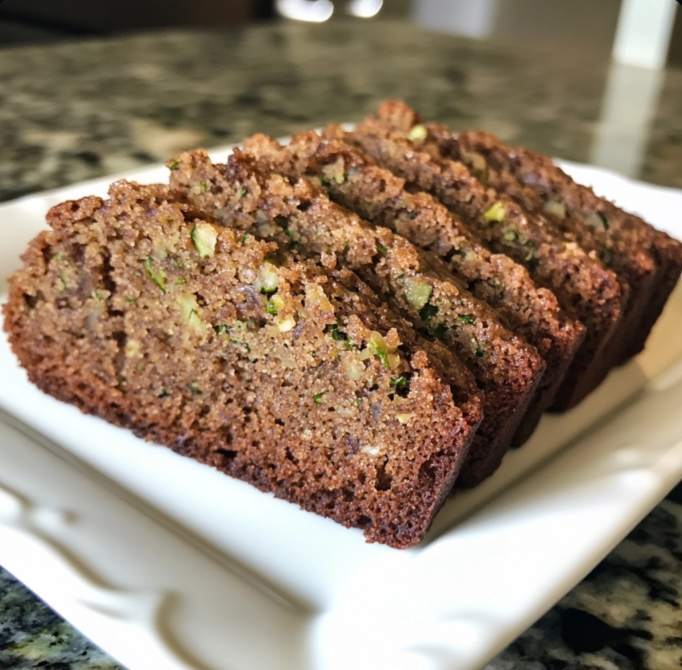Introduction
Gluten-free zucchini bread is a delightful and nutritious option that’s gaining popularity. Whether you’re managing dietary restrictions or just like trying healthier baking alternatives, this bread provides a satisfying and wholesome choice. Zucchini adds moisture and texture, and it’s naturally low in calories, making it a perfect ingredient. By keeping the recipe gluten-free, you accommodate those with gluten sensitivities or celiac disease, ensuring everyone can enjoy its flavor and benefits.
4
This article will walk you through every detail, from understanding key ingredients to perfecting the recipe. With tips on customization and serving, you’ll have everything you need to make the best .
Understanding the Ingredients
The ingredients in gluten free zucchini bread play a crucial role in its taste, texture, and nutritional profile. Here’s a breakdown of the essentials:
- Zucchini: This versatile vegetable is rich in vitamins like C and K, and its high water content ensures a moist bread.
- Gluten-Free Flour: Blends that combine rice flour, almond flour, or tapioca starch work well for a soft and cohesive structure.
- Sweeteners: Many recipes use natural options like honey or maple syrup to keep things healthier.
- Spices: Cinnamon and nutmeg enhance the flavor profile, complementing the zucchini’s subtle taste.
Using high-quality and fresh ingredients can really enhance the flavor and nutritional value of your gluten-free zucchini bread. Always make sure to check labels to confirm that your ingredients are certified gluten-free to avoid any contamination.
Health Benefits of Gluten Free Zucchini Bread
Making gluten free zucchini bread isn’t just about dietary needs; it also boasts a range of health benefits:
- Rich in Nutrients: Zucchini provides essential vitamins, fiber, and antioxidants, supporting overall wellness.
- Low in Calories: This bread is an excellent snack option for those managing calorie intake.
- Easier Digestion: By avoiding gluten, this recipe reduces digestive discomfort for individuals with gluten sensitivities.
- Heart-Healthy Ingredients: Adding nuts or seeds, like walnuts or chia seeds, boosts omega-3 content and provides essential fats.
Incorporating these advantages makes gluten free zucchini bread a smart choice for anyone looking to balance indulgence with health-conscious eating.
Tools and Equipment Needed
To prepare perfect gluten free zucchini bread, you’ll need the right tools and equipment. Here’s a checklist:
- Mixing Bowls: Use separate bowls for dry and wet ingredients to ensure proper mixing.
- Grater: A medium or fine grater works best for shredding zucchini.
- Measuring Cups and Spoons: Accurate measurements are crucial for achieving the desired consistency.
- Loaf Pan: A standard-sized pan ensures even baking.
- Spatula: Use a silicone spatula for scraping every bit of batter.
Having these tools on hand ensures a smooth baking process and consistent results every time you make gluten free zucchini bread.
Step-by-Step Recipe for Gluten Free Zucchini Bread

Ingredients:
- 2 cups gluten-free flour blend
- 1 tsp baking soda
- 1 tsp baking powder
- 1 tsp cinnamon
- ½ tsp nutmeg
- ½ tsp salt
- 1 cup shredded zucchini
- 2 large eggs
- ½ cup coconut oil (melted)
- ½ cup honey or maple syrup
- 1 tsp vanilla extract
Instructions:
- Preheat your oven to 350°F (175°C). Grease your loaf pan lightly.
- In a large bowl, whisk together the gluten-free flour, baking soda, baking powder, cinnamon, nutmeg, and salt.
- In another bowl, combine the eggs, coconut oil, sweetener, and vanilla extract. Mix well.
- Gradually fold the wet mixture into the dry ingredients until just combined.
- Add shredded zucchini and stir gently. Do not overmix to avoid dense bread.
- Pour the batter into the prepared pan and spread evenly.
- Bake for 45–55 minutes or until a toothpick inserted in the center comes out clean.
- Allow the bread to cool for 10 minutes in the pan, then transfer to a wire rack.
Follow these steps for flawless every time.
Common Mistakes and How to Avoid Them
When baking gluten free zucchini bread, even minor missteps can affect the outcome. Here are common mistakes to avoid:
- Skipping the Squeeze: Always squeeze excess water from shredded zucchini to prevent a soggy texture.
- Overmixing: This can result in dense bread. Mix until just combined.
- Incorrect Oven Temperature: Use an oven thermometer to ensure accuracy.
- Substituting Without Testing: While customization is great, altering ingredients too drastically can impact texture.
By steering clear of these pitfalls, you’ll consistently produce delicious gluten free zucchini bread.
Tips for Customizing Gluten Free Zucchini Bread
Personalizing gluten free zucchini bread is easy and adds variety to your baking routine. Consider these options:
- Add-Ins: Incorporate nuts, seeds, or chocolate chips for texture and flavor.
- Flour Variations: Experiment with almond or oat flour for a unique taste.
- Spice Blends: Try adding ginger or cardamom for an extra kick.
- Sweetness Levels: Adjust the amount of honey or maple syrup to suit your preference.
These tips ensure your gluten free zucchini bread never becomes monotonous and always satisfies.
Serving Suggestions
Gluten free zucchini bread can be enjoyed in numerous ways, making it versatile for any time of day:
- Breakfast: Pair with a dollop of Greek yogurt and fresh fruit.
- Snack: Serve warm with a spread of almond butter or honey.
- Dessert: Top with cream cheese frosting for a sweet treat.
The bread also freezes well, so you can prepare in advance and enjoy whenever a craving strikes.
By following this guide, you’ll master gluten free bread and have a reliable recipe for any occasion.
Gluten Free Zucchini Bread: Your Ultimate Guide
Storage and Shelf Life
Knowing how to store gluten free zucchini bread properly ensures it stays fresh and delicious for as long as possible. Gluten-free baked goods tend to dry out faster, so proper storage is crucial.
Tips for Storage:
- Room Temperature: Wrap the bread tightly in plastic wrap or store it in an airtight container for up to two days.
- Refrigeration: For longer freshness, refrigerate the bread. Place it in a sealed container, and it will stay moist for up to a week.
- Freezing: Wrap individual slices in plastic wrap and store them in a freezer-safe bag. When stored this way, can last up to three months.
When ready to eat, thaw the bread at room temperature or warm it in a toaster oven for a freshly baked texture. These techniques help preserve the flavor and consistency of your gluten free zucchini bread.
Gluten Free Zucchini Bread for Special Diets
Gluten free zucchini bread is versatile and can be adapted for various dietary preferences. Whether you’re vegan, keto, or paleo, there are options to suit everyone.
Dietary Adaptations:
- Vegan: Replace eggs with flaxseed or chia seed mixtures, and use coconut oil instead of butter.
- Keto: Use almond flour and a sugar substitute like erythritol to lower carbs.
- Paleo: Opt for coconut flour and natural sweeteners like honey or maple syrup.
By making these adjustments, can accommodate a wide range of dietary needs while remaining flavorful and satisfying.
Comparisons with Traditional Zucchini Bread
How does gluten-free zucchini bread differ from its traditional counterpart? While both versions celebrate zucchini’s moist texture and subtle flavor, the gluten-free version offers unique benefits.
Digestibility
Gluten-free recipes are gentler on the stomach, especially for those with gluten intolerance or sensitivity. This makes it a great option for people following gluten-free diets without sacrificing taste.
Texture
Using gluten-free flour results in a slightly denser bread, but with the right techniques, it can remain tender and moist. Choosing the right blend of flours, like almond or rice flour, can help achieve a light, fluffy texture.
Flavor Options
Gluten-free recipes often incorporate diverse flours like almond or coconut flour, which add distinct, rich flavors that elevate the bread beyond the traditional taste.
Although traditional zucchini bread may have a slight edge in elasticity due to gluten, the creativity and health benefits of gluten-free zucchini bread make it a standout option.
Zucchini Bread: Your Gateway to Gluten-Free Baking
For beginners in gluten-free baking, zucchini bread serves as an ideal starting point. Its forgiving nature makes it less intimidating than other baked goods.
Moisture from Zucchini
The natural water content of zucchini compensates for the drier texture typical of gluten-free flours. This ensures that your bread stays moist without the need for extra additives.
Simple Ingredients
This recipe uses common pantry staples like eggs, oil, and spices, making it easy to prepare even if you’re new to baking. You won’t need any fancy or hard-to-find ingredients.
Versatility
The recipe allows for plenty of experimentation without risking the overall outcome. You can add nuts, chocolate chips, or even swap out flours to suit your taste.
By starting with gluten-free zucchini bread, you build confidence in your baking skills while creating something both delicious and nutritious. It’s a win-win for novice bakers and seasoned pros alike.
FAQs:
Should you peel zucchini for zucchini bread?
No, you don’t need to peel zucchini for zucchini bread. Keeping the skin on adds more nutrients and helps keep the bread moist. Just wash the zucchini well, trim off the ends, and shred it with the skin on to get the best texture and flavor.
What is the biggest challenge of making gluten-free bread?
One of the main challenges in making gluten-free bread is getting the right texture. Since there’s no gluten, the bread can turn out dense or crumbly. To solve this, it’s crucial to use a good mix of gluten-free flours and binders like xanthan gum or guar gum. These ingredients help replicate the elasticity that gluten gives to traditional bread.
Does zucchini have gluten?
No, zucchini does not contain gluten. It is naturally gluten-free, making it a great addition to gluten-freei bread. Zucchini provides moisture and nutrients while allowing the recipe to remain safe for those with gluten sensitivities or celiac disease.
What is a good gluten-free substitute for bread flour?
A great gluten-free substitute for bread flour is a gluten-free flour blend. These blends usually include rice flour, potato starch, and tapioca flour, which help mimic the texture of wheat flour and provide the right structure for baking. To add necessary elasticity, which gluten-free breads often need, consider mixing in xanthan gum or psyllium husk.
Conclusion
is a tasty, nutritious, and versatile choice. Whether you need a gluten-free option, are exploring healthy baking, or want a wholesome snack, this bread meets your needs. Understanding its ingredients and storage is crucial for the best results. Customize the flavors to suit your taste, and enjoy the health benefits of this adaptable recipe. Try making it today for a satisfying, gluten-free treat!

